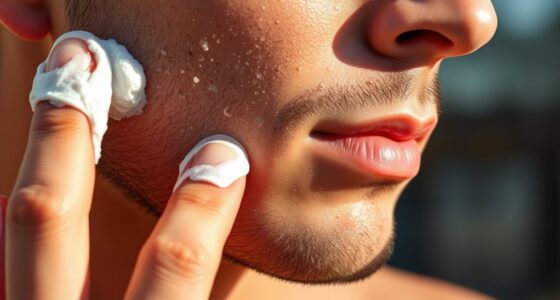When choosing men’s body sunscreen, consider your skin type—go for moisturizers if you have dry or sensitive skin, or lightweight, non-comedogenic formulas if you’re oily or prone to breakouts. Match your activity level with water-resistant, broad-spectrum SPF 30+ sunscreens, and remember to reapply every two hours. Pay attention to often-missed spots like ears and feet, and opt for hydrating formulas to keep your skin comfortable. To get all the tips, keep exploring further.
Key Takeaways
- Choose sunscreens suitable for your skin type, such as moisturizers for dry skin or non-comedogenic formulas for oily skin.
- Use broad-spectrum SPF 30+ sunscreens and reapply every two hours during outdoor activities or water exposure.
- Apply sunscreen 15 minutes before sun exposure, covering all exposed areas including often-missed spots like ears and feet.
- Opt for water-resistant sunscreens if swimming or sweating, and reapply promptly after water activities.
- Incorporate hydrating sunscreens with ingredients like aloe vera or glycerin to maintain skin moisture and prevent dryness.

When choosing a body sunscreen, men should consider their skin type, activity level, and the typical sun exposure they face. Your skin type influences how your skin reacts to different formulas. If you have dry or sensitive skin, look for sunscreens with added moisturizers or skin hydration ingredients like aloe vera or glycerin. These help prevent your skin from drying out or becoming irritated after sun exposure. On the other hand, if your skin tends to be oily or acne-prone, opt for a lightweight, non-comedogenic sunscreen that won’t clog pores or feel heavy on your skin.
Your activity level plays a vital role in determining the best sunscreen for you. If you spend a lot of time outdoors, especially during peak sun hours, choose a broad-spectrum sunscreen with a high SPF—preferably 30 or above. For active lifestyles involving swimming or sweating, look for water-resistant options that stay on your skin despite moisture. Applying enough sunscreen is also key; aim for about one ounce (a shot glass full) to adequately cover all exposed areas. Reapply every two hours or immediately after sweating or swimming to maintain effective protection.
The typical sun exposure you face influences your sunscreen selection and how you use it. If you work outdoors or enjoy outdoor sports, your skin is exposed to the sun’s rays for extended periods, so consistent reapplication becomes essential. For shorter periods outdoors, a daily body sunscreen with sufficient SPF can suffice, but don’t skip reapplying if you’re active or sweating. Remember, sun protection tips include applying sunscreen at least 15 minutes before sun exposure, covering all exposed skin thoroughly, and paying special attention to often-missed spots like the back of your neck, ears, and feet.
Another important consideration is skin hydration. Prolonged sun exposure can dehydrate your skin, leading to dryness and irritation. Incorporate sunscreens with moisturizing ingredients to help keep your skin hydrated and protected at the same time. It’s also helpful to use after-sun lotions or moisturizers that contain soothing ingredients like chamomile or vitamin E to restore moisture and reduce redness.
Frequently Asked Questions
Is SPF 50 Necessary for Everyday Use?
You don’t necessarily need SPF 50 for everyday use, but it depends on your skin and environment. SPF comparison shows that SPF 30 blocks about 97% of UVB rays, while SPF 50 offers slightly more protection. Look for sunscreen ingredients like zinc oxide or avobenzone for broad-spectrum coverage. If you’ll be outdoors a lot or near water, SPF 50 provides extra peace of mind, but for daily errands, SPF 30 often suffices.
How Often Should I Reapply Sunscreen During Outdoor Activities?
Think of your skin as a fortress guarding precious assets. During outdoor activities, you should reapply sunscreen every two hours to keep that fortress strong. If you’re swimming or sweating heavily, reapply immediately afterward. These outdoor activity tips help guarantee continuous protection. Staying vigilant with reapplication frequency prevents sun damage, so you can enjoy your time outside confidently, knowing your skin remains shielded from harmful rays.
Can Sunscreen Clog Men’s Pores or Cause Breakouts?
Sunscreen can clog pores and cause breakouts if it’s greasy or comedogenic. To prevent pore clogging and breakouts, choose a non-comedogenic, oil-free formula designed for your skin type. Make sure to wash off sunscreen thoroughly after outdoor activities to avoid pore buildup. If you notice breakouts, switch to a lightweight, mattifying sunscreen and test different brands to find one that works best for your skin.
Are There Specific Sunscreens Formulated for Sensitive Skin?
You’ll be glad to know there are sunscreens specially designed for sensitive skin. These formulations often come as hypoallergenic options, so you don’t have to worry about irritation or breakouts. Imagine applying a gentle, soothing shield that’s like a calming breeze on a hot day—no stinging, just protection. Look for labels that specify sensitive skin formulations, and you’ll enjoy sun safety without sacrificing comfort or peace of mind.
Should I Apply Sunscreen on Shaded or Cloudy Days?
Yes, you should still apply sunscreen on cloudy or shaded days. Cloud cover and shade don’t block all UV rays, which can still penetrate your skin and cause damage. UV rays reflect off surfaces like water, sand, and pavement, increasing exposure. So, even when it’s overcast or shaded, wearing sunscreen helps protect your skin from harmful UV rays and prevents long-term damage.
Conclusion
Remember, choosing the right sunscreen isn’t just about protection—it’s about staying healthy long-term. Did you know that people who regularly wear sunscreen can reduce their skin cancer risk by up to 50%? So, make it a habit to apply a broad-spectrum, sweat-resistant sunscreen daily, especially if you’re active outdoors. Protecting your skin now means fewer worries later. Stay consistent, stay safe, and enjoy your time outside without compromise.









